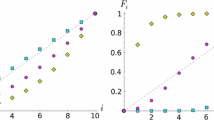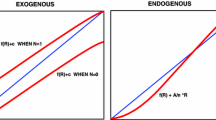Abstract
We study a class of Markovian systems of N elements taking values in [0,1] that evolve in discrete time t via randomized replacement rules based on the ranks of the elements. These rank-driven processes are inspired by variants of the Bak–Sneppen model of evolution, in which the system represents an evolutionary ‘fitness landscape’ and which is famous as a simple model displaying self-organized criticality. Our main results are concerned with long-time large-N asymptotics for the general model in which, at each time step, K randomly chosen elements are discarded and replaced by independent U[0,1] variables, where the ranks of the elements to be replaced are chosen, independently at each time step, according to a distribution κ N on {1,2,…,N}K. Our main results are that, under appropriate conditions on κ N , the system exhibits threshold behavior at s ∗∈[0,1], where s ∗ is a function of κ N , and the marginal distribution of a randomly selected element converges to U[s ∗,1] as t→∞ and N→∞. Of this class of models, results in the literature have previously been given for special cases only, namely the ‘mean-field’ or ‘random neighbor’ Bak–Sneppen model. Our proofs avoid the heuristic arguments of some of the previous work and use Foster–Lyapunov ideas. Our results extend existing results and establish their natural, more general context. We derive some more specialized results for the particular case where K=2. One of our technical tools is a result on convergence of stationary distributions for families of uniformly ergodic Markov chains on increasing state-spaces, which may be of independent interest.
Similar content being viewed by others
References
Asmussen, S.: Applied Probability and Queues, 2nd edn. Springer, New York (2003)
Aspandiiarov, S., Iasnogorodski, R.: General criteria of integrability of functions of passage-times for non-negative stochastic processes and their applications. Theory Probab. Appl. 43, 343–369 (1999); translated from Teor. Veroyatn. Primen. 43 (1998) 509–539 (in Russian)
Aspandiiarov, S., Iasnogorodski, R.: Asymptotic behaviour of stationary distributions for countable Markov chains, with some applications. Bernoulli 5, 535–569 (1999)
Aspandiiarov, S., Iasnogorodski, R., Menshikov, M.: Passage-time moments for nonnegative stochastic processes and an application to reflected random walks in a quadrant. Ann. Probab. 24, 932–960 (1996)
Bak, P., Sneppen, K.: Punctuated equilibrium and criticality in a simple model of evolution. Phys. Rev. Lett. 71, 4083–4086 (1993)
de Boer, J., Derrida, B., Flyvbjerg, H., Jackson, A.D., Wettig, T.: Simple model of self-organized biological evolution. Phys. Rev. Lett. 73, 906–909 (1994)
de Boer, J., Jackson, A.D., Wettig, T.: Criticality in simple models of evolution. Phys. Rev. E 51, 1059–1074 (1995)
Burke, C.J., Rosenblatt, M.: A Markovian function of a Markov chain. Ann. Math. Stat. 29, 1112–1122 (1958)
Chung, K.L.: Markov Chains with Stationary Transition Probabilities, 2nd edn. Springer, Berlin (1967)
Durrett, R.: Probability: Theory and Examples. Wadsworth & Brooks/Cole, Pacific Grove (1991)
Fayolle, G., Malyshev, V.A., Menshikov, M.V.: Topics in the Constructive Theory of Countable Markov Chains. Cambridge University Press, Cambridge (1995)
Flyvbjerg, H., Sneppen, K., Bak, P.: Mean field theory for a simple model of evolution. Phys. Rev. Lett. 71, 4087–4090 (1993)
Garcia, G.J.M., Dickman, R.: On the thresholds, probability densities, and critical exponents of Bak–Sneppen-like models. Physica A 342, 164–170 (2004)
Gillett, A.J.: Phase Transitions in Bak–Sneppen Avalanches and in a Continuum Percolation Model, PhD thesis, Vrije Universiteit, Amsterdam (2007)
Gillett, A., Meester, R., Nuyens, M.: Bounds for avalanche critical values of the Bak–Sneppen model. Markov Process. Relat. Fields 12, 679–694 (2006)
Gillett, A., Meester, R., Van Der Wal, P.: Maximal avalanches in the Bak–Sneppen model. J. Appl. Probab. 43, 840–851 (2006)
Grinfeld, M., Knight, P.A., Wade, A.R.: Bak–Sneppen-type models and rank-driven processes. Phys. Rev. E (2010, to appear). arXiv:1011.1777
Hajek, B.: Hitting-time and occupation-time bounds implied by drift analysis with applications. Adv. Appl. Probab. 14, 502–525 (1982)
Head, D.A., Rodgers, G.J.: The anisotropic Bak–Sneppen model. J. Phys. A, Math. Gen. 31, 3977–3988 (1998)
Jensen, H.J.: Self-Organized Criticality. Cambridge University Press, Cambridge (1998)
Labzowksy, G.L., Pis’mak, Yu.M.: Exact analytical results for the Bak–Sneppen model with arbitrary number of randomly interacting species. Phys. Lett. A 246, 377–383 (1998)
Lamperti, J.: Criteria for stochastic processes II: passage-time moments. J. Math. Anal. Appl. 7, 127–145 (1963)
Meester, R., Znamenski, D.: Limit behavior of the Bak–Sneppen evolution model. Ann. Probab. 31, 1986–2002 (2003)
Meester, R., Znamenski, D.: Critical thresholds and the limit distribution in the Bak–Sneppen model. Commun. Math. Phys. 246, 63–86 (2004)
Menshikov, M.V., Popov, S.Yu.: Exact power estimates for countable Markov chains. Markov Process. Relat. Fields 1, 57–78 (1995)
Meyn, S., Tweedie, R.L., Chains, Markov: Stochastic Stability, 2nd edn. Cambridge University Press, Cambridge (2009)
Moulin, H.: Game Theory for the Social Sciences, 2nd edn. New York University Press, New York (1986)
Pemantle, R.: A survey of random processes with reinforcement. Probab. Surv. 4, 1–79 (2007)
Pis’mak, Yu.M.: Exact solution of master equations for a simple model of self-organized biological evolution. J. Phys. A, Math. Gen. 28, 3109–3115 (1995)
Tweedie, R.L.: The existence of moments for stationary Markov chains. J. Appl. Probab. 20, 191–196 (1983)
Author information
Authors and Affiliations
Corresponding author
Rights and permissions
About this article
Cite this article
Grinfeld, M., Knight, P.A. & Wade, A.R. Rank-Driven Markov Processes. J Stat Phys 146, 378–407 (2012). https://doi.org/10.1007/s10955-011-0368-7
Received:
Accepted:
Published:
Issue Date:
DOI: https://doi.org/10.1007/s10955-011-0368-7




